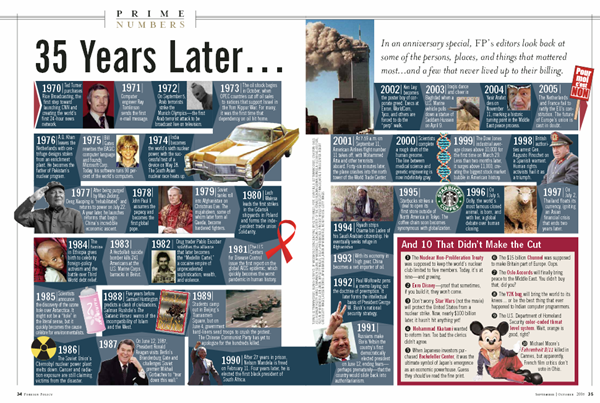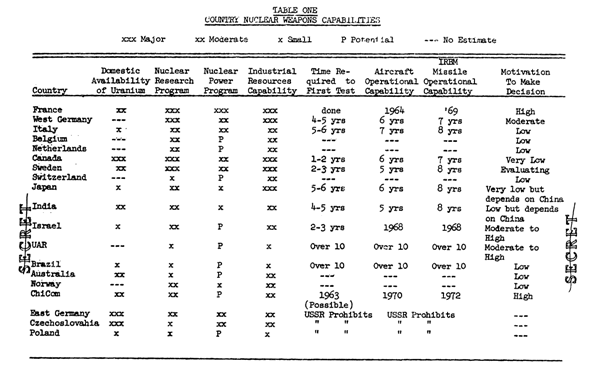The editors of Foreign Policy magazine “look back at at some of the persons, places and things that mattered most … and a few that never lived up to their billing.”
The Number One Disappointment of the last 35 years? The Nuclear Non-Proliferation Treaty:
The Nuclear Non-Proliferation Treaty was supposed to keep the world’s nuclear club to five members. Today, it’s at nine—and growing.
What trash.
Let’s start with a very simple concept: the control group—the group of patients that serves as the basis of comparison when assessing the effects of the intervention given to patients in the treatment group.
You don’t compare the patients at the end of the trial with the same patients at the start. Of course, we don’t have a control group—a world without the nonproliferation regime—for comparison. Well, at least not yet.
But we do have some sense of how policymakers looked at the potential for proliferation before the NPT. Most famously, President Kennedy warned in 1963 that, by the 1970s, many countries might possess nuclear weapons:
I see the possibility in the 1970’s of the President of the United States having to face a world in which 15 or 20 or 25 nations may give these weapons. I regard that as the greatest possible danger and hazard.
Kennedy’s estimate was based on a 1963 briefing paper provided by Secretary of Defense Robert McNamara. (For a review of the National Intelligence Estimates on which McNamara drew, see National Intelligence Estimates of the Nuclear Proliferation Problem The First Ten Years, 1957-1967)
Here is McNamara’s chart …
You may be shocked by some of the names you see. Don’t be. Before the NPT, nuclear weapons were seen by many people as just another weapon, part of any modern military’s future arsenal. In fact, virtually all the non-Warsaw Pact countries on this list seriously considered a nuclear weapons program.
Australia, Sweden and Switzerland all had active nuclear weapons programs. The NPT helped changed that. In the case of Australia, Jim Walsh has a particularly lucid account of the role played by the NPT in constraining Canberra’s nuclear aspirations.
Of 44 nuclear capable states (precisely: states listed in Annex II of the CTBT), only nine have nuclear weapons.
Against the broad and deep success of the nonproliferation regime in preventing most nuclear capable nations from building nuclear weapons, the editors of Foreign Policy suggest four additional nuclear powers render the NPT the greatest disappointment of the last thirty five years (Aside: The 1972 Paris Peace Accords did not make this list. How is that possible?)
Hanging the four new nuclear states—Israel, India, Pakistan and North Korea—on the NPT is bizarre, since all four built their weapons outside the NPT regime.
- Israel, India, Pakistan have always refused to sign the treaty. By the time Indian and Israeli policymakers began to consider whether to sign the NPT in the late 1960s, both programs were considerably more advanced than, say, the Iranian program today. Pakistan also acquired its nuclear capabilities outside the regime, largely through industrial espionage and Chinese assistance (before China was a signatory to the NPT).
- North Korea was also a nonsignatory to the treaty when the Soviets began construction of a plutonium production reactor in 1982. The Soviets may have pressured North Korea to join the NPT in 1985 as a condition of supplying the reactor, but Pyongyang delayed signing an inspections agreement for several years. Eventually—after no small effort by the first Bush Administration—inspectors got access in 1992 and … whammo! … The IAEA caught Pyongyang cheating.
The NPT had nothing to do with these failures, save playing an important role in catching the North Koreans cheating.
FP also notes that the nuclear club is “growing,” but that is just a lame reference to Iran.
Iran may be an outstanding issue, but a number of programs have been shut down including Argentina, Brazil, South Korea, Taiwan and, most dramatically, South Africa—which voluntarily dismantled its small nuclear stockpile.
It’s a little early to trash the NPT over the possibility that Iran might build nuclear weapons. I can tell you this: Avoiding that outcome will require IAEA monitoring under the NPT regime. Look at this way: Even after an airstrike to eliminate the Iranian facilities we know about, we will still need IAEA inspections to make sure Iran doesn’t reconstitute the program (as Saddam Hussein did after the 1981 Israeli strike on the Iraq’s Al-Tuwaitha reactor). Unless we want to regularly schedule air strikes on Iran every couple of years.
Number One on my list of things that haven’t lived up to their billing in the past 35 years: Foreign Policy magazine.



Seems to me that this trashing of the NPT is part of a greater effort to undermine the existing Non-Proliferation norms, particularly the aspects which recognize a right by non-weapons states to possess civilian nuclear technology.
Correct me if I’m wrong please but, I was under the impression that the South Africans voluntarily dismantled their weapons due to:
a) Having no credible target that would require their potential use, and;
b) It was an expensive pointless program.
The NPT had absolutely nothing to do with their decision to terminate the program.
Frankly bringing it up in the context of the NPT being successful… which by and large I agree it is… is a bit disingenuous as the NPT doesn’t appear to have been a concern at all to South Africa over the lifespan of it’s program.
So, I looked at the page listing the board and editorialists at Foreign Policy.
It’s led by someone who H Chavez of Venezuela tried to overthrow.
Damn the treaties, arm the warheads, the communists are the leftists are the socialists are the enemies.
Didn’t “we” win the Cold War, after all?
God Bless Executive Pay
The obvious counterpoint seems to be that what really tipped the scales for most of these would-have-been nuclear powers was American assurances of a nuclear umbrella. Even if we accept that kind of hard power argument at face value, however, there is no way that a country like Sweden would have accepted such an assurance without the fig leaf of an international legal framework.
Of course, international law is arguably much more than a fig leaf for hard power. At any rate, the NPT must surely get a good rating when compared to other international legislation. Take The International Bill of Human Rights (1), for example. If we were (as FP mag with the NPT) to compare its intentions to today’s reality, we might really have reason to be disappointed.
(1) http://www.ohchr.org/english/about/publications/docs/fs2.htm